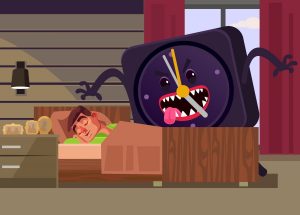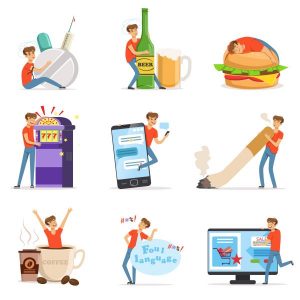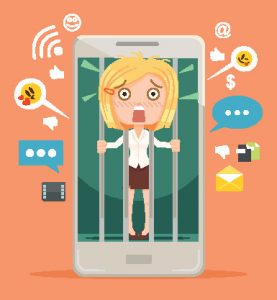I pulled out all the sleep aids from my bedside table drawer: ear plugs, herbal sleep spray, aromatherapy pulse point essential oil, sleeping tablets, and lavender spray. I’ve tried them all with some success. Having something on hand just in case we can’t sleep can be a good idea. In this second blog post on sleep, I’ll be concentrating on resources and aids. According to the Centers for Disease Control and Prevention (CDC)1, one third of adults in the United States are not getting a healthy amount of sleep. Why is a good night’s sleep so important? Lack of sleep can lead to chronic illness and conditions such as obesity, heart disease and depression. Vehicle accident statistics show an alarming rate of disability and fatalities after the driver has fallen asleep at the wheel. In my previous blog, Seven Solutions for a Better Sleep: #1, we looked at 7 areas, each starting with a letter from the word …
Seven Solutions For Better Sleep: #1
Dead at midnight, a blaring sound filled my ears. Adrenaline coursed through my veins. Had the emergency services arrived at my house? Thankfully not. The blast came from my back-up alarm, which I’d knocked on during a bedside table clean. I patted my annoyed better-half in sympathy and eventually went back to sleep. The next morning I woke to the low-volume buzz of my usual default radio alarm and then rushed off into the next day. But I hate to admit it—I had forgotten to turn off the midnight alarm. It hit my ears in a rude awakening at 12 am. again. This time I gritted my teeth. Angry and cortisol-fuelled. It would take ages to relax back into a slumber. There are many strategies to improve both the quantity and quality of our sleep. Here are seven areas that will help, each starting with a letter from the word DREAMER: DIETROUTINEENVIRONMENTACKNOWLEDGEMENTMEDICINEENJOYMENTRESOURCES DIET What and when you eat and drink may influence how well you sleep. It’s best to …
8 Keys to Help You Break Out of the Anxiety Trap.
Here are 8 practical keys to help you escape from the anxiety trap and find freedom. Our world has been hijacked in a surging tsunami of uncertainty, with COVID-19 and social distancing. You may be a health worker, stressed and stretched beyond the limit. Perhaps you have financial and job worries. News articles acknowledge that anxiety is on the rise. This emotion is important for our survival, but when it takes over our everyday life, we need to take action. When we’re anxious, the three main stress hormones adrenaline, cortisol and norepinephrin are released into our brains, and these can damage our organs and bodies. We can learn strategies to change our mindset. But first, how do you know if your symptoms are stress and anxiety? Here are some indications: Taking addictive substances or addictive behavioursConstant fear or worryNervousnessSleep problemsEating disordersProblems coping with lifeRestlessness I have 8 keys to offer you in your escape from the …
Get Rid of Bad Habits.
Habits are part of life but they can cause us or the people around us harm. Here are some common habits many people struggle with: SmokingChewing on fingernailsBingeing on NetflixEating too much fast foodDrinking too much alcoholCompulsive online shopping (I can relate to this one- my weakness is Bookbub)Not getting enough sleepConstant swearing Get medical advice and supervision if you are stopping a more serious substance abuse addiction to safely withdraw from the substance. What is a Habit? It’s a set behavior that follows a cycle that we subconsciously carry out. It involves a trigger and reward. The brain hardwires everything we repeatedly do. What makes us perform the habit? It can occur after a particular trigger, it could be a time or place or a reaction to an emotional swing. We get a positive feeling from the behavior due to the release of feel-good neurochemicals in our brains. How do we stop the habit? It’s important to take note of what the …
Help and Hope for Technology Addiction
I remember the days of local area network (LAN) parties, when my sons would wire up our rumpus room like a tech lab, with as many computers as they could find. They would invite like-minded friends, have good supply of chips and popcorn, and play computer games all night! Little did we know that there would be such a thing as computer addiction! Little did I expect my school students to complain of a computer or gaming addiction, and confess they were powerless to stop it. Digital addiction, social media addiction, gaming addiction, internet compulsions and ‘Digital Cocaine’? What are these? Are they serious disorders? We have enough evidence to know technology addiction does exist, and it needs to be addressed. The negative consequences of the addiction can be far-reaching and devastating. But there are so many positives about screentime as well:Using technology to educate, such as watching a video, doing a tutorial or researching on the internet is invaluable for the workplace, …
Curb the cravings during COVID 19
Are you feeling stressed, swamped under, and anxious with the COVID 19 restrictions and uncertainties?Are you fearing what the future will bring? Family, relationships, work, financial and health worries?You aren’t alone. We are all affected in various degrees. Many of us are complaining of unusual tiredness and weight gain. Many are at home or in quarantine, isolated and sedentary. Maybe sitting for hours either at our computers, or lounging on the sofa binging on Netflix and unhealthy food. We may be drinking more alcohol, seeking escape with technology to the detriment of the family or our employment, and taking more medication and various drugs to dull the pain. We may be too tired or depressed to exercise. What can we do to avoid the downward spiral? Here are a few strategies to try. Change the activity or what you are viewing that is causing you to crave—until the feeling eases.Remind yourself of all the good things that have happened in the past week. What are you …






